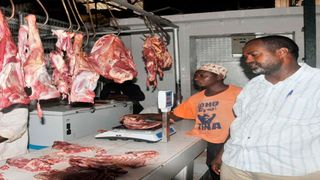
A customer buys meat at Marikiti market in Mombasa in 2020.
| File | Nation Media GroupSeeds of Gold
Premium
Meat policies and laws you need to know
What you need to know:
- Kenya is a signatory to international instruments that handle meat issues across all the value chains.
- Meat has a short shelf-life and the likelihood of it becoming a human health hazard is real.
Meat is both food and a trading commodity. It is derived from different species of animals, which are either domesticated or wild.
For meat to be legally acceptable as food, the source must be gazetted as a food animal and meat obtained thereon must be inspected to assure its safety for human consumption.
Kenya has developed a raft of policies and legislative frameworks to govern and regulate the meat industry, guided by international best practices, which have been turned into treaties, protocols and agreements. Kenya is a signatory to these international instruments that handle meat issues across all the value chains.
These treaties and protocols bind Kenya to adhere to the set international standards so that it can access global meat markets, prevent zoonotic diseases and spread of animal diseases across the national boundaries.
Global meat policy framework
The World Animal Health (OIE) is accredited by the World Trade Organization (WTO) and World Health Organization (WHO) as the leading global agency in developing guidelines for handling meat.
These guidelines also provide for regulations on trade of animals and animal products. The Codex Alimentaris Commission, which is a joint standards programme of the Food and Agriculture Organization (FAO) and WHO aspire to protect public health by developing standards and encouraging their implementation.
It also sets codes of practice, guidelines and recommendations covering all aspects of food and feed safety, including their handling and distribution. The commission utilises the International Plant Protection Convention (IPPC) and OIE provisions to guarantee food safety. Using these global guidelines, Kenya has developed policies, legislations and governance structures and institutions to regulate, control and safeguard meat quality and trade.
Why develop meat policy and legislative frameworks
Meat has a short shelf-life and the likelihood of it becoming a human health hazard is real. There is need, therefore, to ensure that its production, processing, storage and transportation is safeguarded throughout the whole value chain by a functional regulatory and institutional framework.
The regulatory instruments for trade have to ensure that issues of grading, standardisation, labelling of dates of processing and expiry, among others, are spelt out and sanctions are put in place to discipline the errant value chain actors through an established governance system.
Administration of these policy instruments should be conducted by trained, qualified, registered, certified and licensed personnel. Meat is a sensitive animal product and, therefore, its production, processing, handling and preparation for human consumption should be done in highly regulated and controlled environment, using strict standards set universally to ensure human safety.
Meat policies and legislations
A number of policies directly affect the meat industry. They include:
Vision 2030 medium term plan III and Agenda 4: This seeks to attain 100 per cent food and nutrition security, and therefore, achieve a globally competitive and prosperous country with high quality life by 2030 to which meat contributes to.
Sessional Paper No.2 of 2020 on Veterinary Policy: It provides direction on safeguarding safety of food of animal origin, sanitary standard of animal feeds, inspection and certification of premises and equipment for use in meat industry.
Sessional paper No.3 of 2020 on livestock policy: It provides direction for meat production, marketing of meat animals and meat products and value addition of meat.
Agriculture Sector Transformation and Growth Strategy: It provides a guideline on transformation of agricultural value chains into commercial entities through targeted investment.
Other key policies governing meat industry include that on veterinary laboratory and foot and mouth disease.
For legislations, they cover the entire value chain starting from production of meat animals, including their feeding and handling, humane slaughter, disease control including major zoonotics like rabies that can be spread by meat, control of parasites to ensure quality is maintained, control and surveillance of contaminant in meat products including heavy meat drugs radioactive materials and mycotoxins among others. They are:
- Meat Control Act
- Kenya Meat Commission Act
- Rabies Act
- Cattle cleansing Act
- Veterinary Surgeons and Veterinary Para-professionals Act
- Prevention of Cruelty to Animals’ Act
- National Biosafety Authority Act
- Food, Drugs and Chemical Substance Act
- Animal Disease Act
- Uplands Bacon Factory Act
- Fertilisers and Animal Feedstuff Act
- Public Health Act
Challenges
Some frameworks are obsolete, contradicting or irrelevant. Their review is a protracted process that takes a long time and requires a lot of resources for public participation, they are expensive to enforce and they are too many. The concept of self-responsibility and regulation has not been embraced by Kenyans.
The state department, however, is in the process of reviewing all livestock legislations with the aim of consolidating them, expunging others and making them relevant to the current situation.
Mr Ombae is the assistant director livestock policy research and regulations, State Department for Livestock. [email protected]




